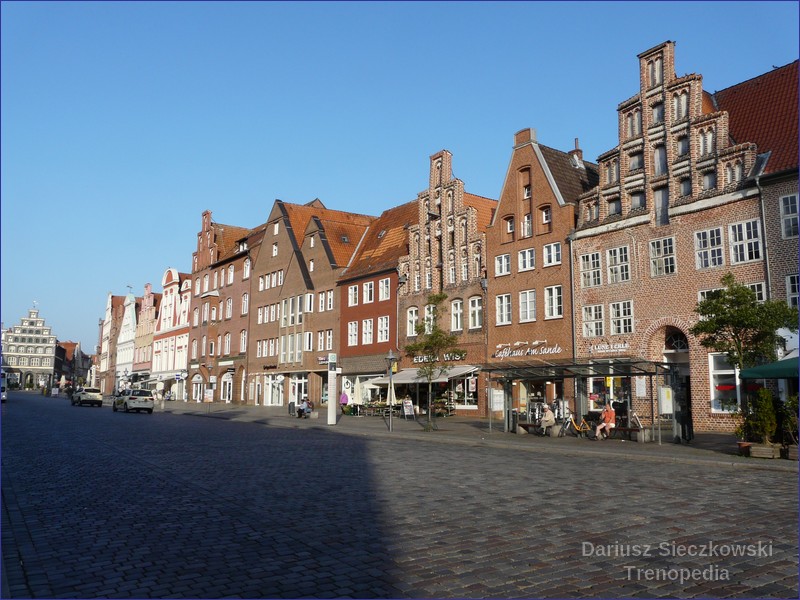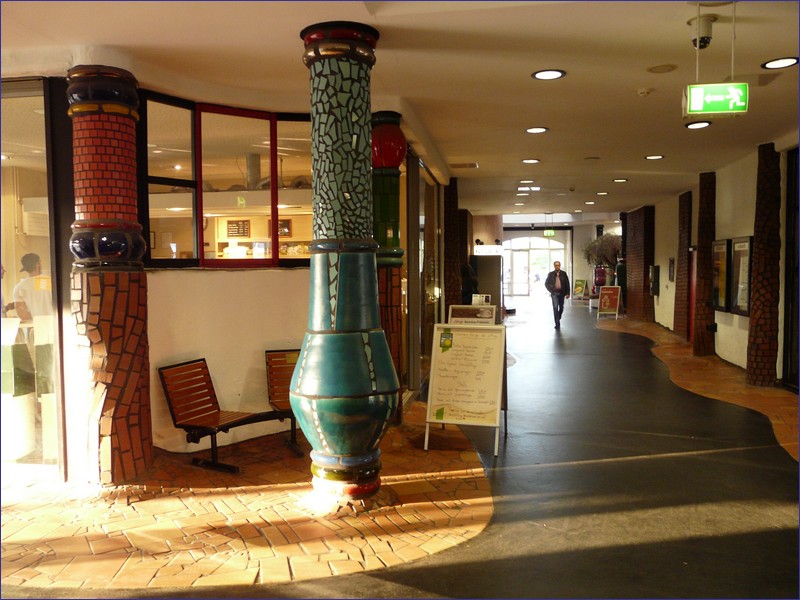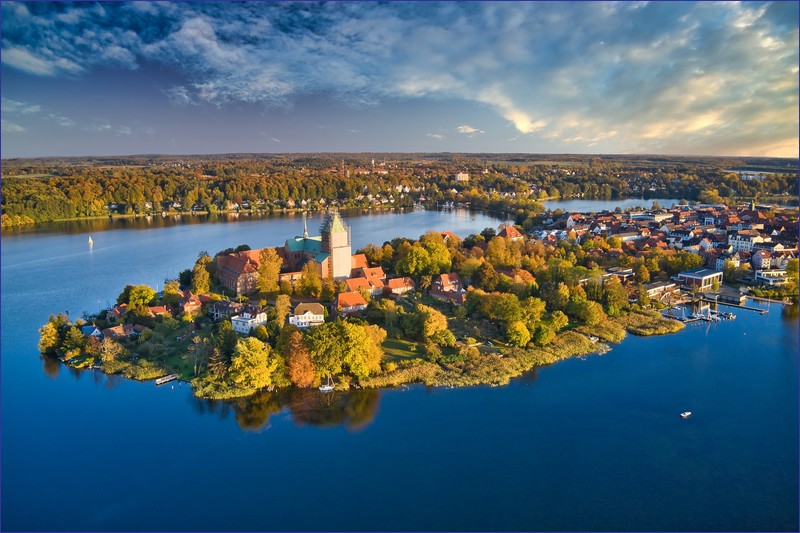Hamburg is the second-largest city in Germany. When exiting the train station, it may initially seem like an unremarkable metropolis, but the main sights are spread out across a wide area. It is also an important railway hub – thanks to numerous rail connections, it’s easy to organize day trips from Hamburg by train.
I’ve listed only the most important destinations that can be reached by regional trains from Hamburg within two hours (R, RE). In some cases, a transfer is necessary. In the future, I plan to expand this article with other interesting places. Long-distance trains connect Hamburg to many major cities but are much more expensive.
Direction: Hanover
Lüneburg – a place definitely worth visiting, historically known for salt mining. Once a Hanseatic city, it was among the wealthiest cities in Germany during its heyday. The old town is quite charming. The main attraction is the town hall; if possible, be sure to see the Town Hall Chamber with stained glass and frescoes of the “Last Judgment” and the “Council Hall.” On Am Sande Square stands the Gothic Church of St. John with a 108-meter-high western tower leaning 2 meters off vertical. Also worth seeing is St. Nicholas’ Church. The walk from the train station to the city center takes about 5 minutes, and the center boasts lovely architecture, picturesque streets, the Lüneburg Museum, and the Salt Museum. Nearby are the Lüneburg Heath and Südheide nature parks with vast heathlands. Highly recommended.

Uelzen (optional) – train enthusiasts should stop here for at least a short visit to see the fairytale-like train station. The interior also reflects a whimsical, storybook style. The Old Town, located just a 3-minute walk from the station, consists of a few streets with attractive, well-maintained buildings.

Celle – a town of about seventy thousand residents. The Old Town lies near a castle that was rebuilt in 1583 as a residence. Part of the castle is a Gothic chapel remodeled in the Mannerist style by Martin de Vos, who painted 76 works inside. The center features beautiful half-timbered houses. In recent years, so-called “Talking Lanterns” have been installed. Worth visiting are the Art Museum and the Garrison Museum located in former barracks. The walk from the train station to the city center is about 2 kilometers. During my visit, I found no public restrooms at the station or along the way (I finally found one at the castle).

Hanover – a large city, the capital of Lower Saxony, and an important rail hub. Most historical buildings were destroyed during WWII. Some were rebuilt, but the city doesn’t particularly impress. Outside the center, the Royal Gardens with the Welf Palace and Herrenhausen Palace are notable, as well as the university, some religious monuments, and the zoo. The beautiful train station is located in the city center – within walking distance is the massive New Town Hall (1901–1913). Museum lovers can visit the Sprengel Museum, opened in 1979 and one of the most important modern art museums in Germany; the Lower Saxony State Museum with art, nature exhibits, and an aquarium; or the Historical Museum. The most picturesque central street is Kramerstraße with preserved half-timbered houses. The ruins of the Aegidienkirche also make an impression.

Direction: Lübeck
Ahrensburg – in the northern part of the town stands a water castle (Wasserschloss Ahrensburg) with distinctive white walls. Built at the end of the 16th century on the site of a medieval fortified manor, it now houses a museum.
Lübeck – worth visiting for its numerous preserved Gothic monuments. A former capital of the Hanseatic League. The main sights are within the Old Town, easily explored on foot. Don’t miss Germany’s most famous brick town hall, built starting in 1226, the Mengstrasse with picturesque Gothic townhouses with stepped gables, St. Mary’s Church located behind Rathausplatz, and the cathedral, whose construction began in 1173 under Henry the Lion. From the train station to the Old Town, you’ll pass through the Holstentor – a restored medieval brick gate that now houses a museum dedicated to Lübeck’s history. Other interesting museums include the European Hansemuseum, the Buddenbrookhaus dedicated to author Thomas Mann, and the St. Annen museum quarter. One of Lübeck’s districts, Travemünde, is a popular Baltic Sea holiday destination.

Ratzeburg (optional) – you can transfer in Lübeck onto the RE train to Lüneburg. It goes through the town of Ratzeburg, located on an island in Lake Grosser Ratzeburger See, connected to the mainland by three causeways. In 1154, Henry the Lion founded a bishopric here; later, the Dukes of Lauenburg resided in Ratzeburg. The town’s symbol is the Romanesque cathedral founded by Henry the Lion, marking the bishopric’s establishment. Next to the cathedral is a well-preserved medieval monastery from the late 13th century with impressive frescoes.

Direction: Kiel
Kiel (optional) – a city largely destroyed during WWII. It’s where the Kiel Canal begins and is an important port. Architecturally, it’s average; you can stroll along the waterfront (Schwedenkai), see the town hall and St. Nicholas’ Church with its baptismal font and Gothic altar. Kiel fares much better in terms of museums – notable ones include the Maritime Museum, Zoological Museum of Kiel University, City Museum, Computer Museum at the Vocational School, Geology and Mineralogy Museum, and the Machinery Museum Kiel Wik on the outskirts. Eight kilometers south of the city lies one of Germany’s best open-air museums: Freilichtmuseum Molfsee.

Direction: Schwerin
Schwerin – a beautiful city surrounded by lakes that survived WWII without destruction. The Old Town stretches between the train station and Lake Schweriner See. The city’s most famous landmark is the Neo-Renaissance castle located on an island in the lake. The castle’s current form is the result of reconstruction between 1845–1857, inspired by French Renaissance châteaux. Part of the castle houses the Mecklenburg-Vorpommern state parliament, while the rest is open to tourists as a museum with an extensive art collection. Visitors can tour the chapel, Throne Room, and dining hall. Other sights in the charming city center include the town hall, cathedral, market hall (1783–1785), and historic townhouses. On the outskirts, you can visit a small open-air museum, a modest Firefighting Museum, and the zoo. The Zippendorf district features beaches.

Direction: Stade
Stade – a medieval Hanseatic town. The Old Town, mainly composed of half-timbered houses, has been preserved. The most beautiful part is by the Old Port. The Swedish Warehouse (Schwedenspeicher) houses an interesting museum dedicated to Stade’s history, with permanent exhibits including scale models of the town from various eras. Noteworthy is the 1667 town hall, with Dutch architectural influences. A small open-air museum is located on one of the river Schwinge’s islands.
Direction: Bremen
Bremen – a large city on the Weser River, founded in 787. From the beautiful train station, it’s a 10-minute walk to the Old Town, or you can take a tram. The main landmarks are located around a large, irregularly shaped market square. The majestic town hall (Bremer Rathaus) dates from the 15th century and was rebuilt in the Weser Renaissance style from 1609–1612. In front stands a 12-meter statue of the legendary knight Roland. St. Peter’s Cathedral towers over the Old Town, and one of the city’s symbols is the Statue of the Bremen Town Musicians, inspired by the Brothers Grimm fairytale. Notable buildings include the richly decorated Guild House (Schütting), built in Dutch Mannerist style, once used by local merchants. The oldest district, Schnoor, features a maze of streets lined with 15th–17th-century timber-framed buildings. Among the many museums is the Focke Museum, showcasing Bremen’s history and culture from the Middle Ages to modern times. Also far from the Old Town is Universum Bremen, a science center about Earth and space. Right next to the train station is the Overseas Museum (founded in 1891), focused on the cultures of overseas countries.
Day trip from Hamburg by train – Direction: Husum
Husum (optional) – a charming town on the route from Hamburg-Altona to Westerland, located on the Wadden Sea. A perfect place for a walk among low historic buildings. The town features several small museums, such as the North Frisian Maritime Museum and the North Sea Museum Husum. The most important building is St. Mary’s Church, one of the most significant Classicist buildings in Schleswig-Holstein.
Related articles:
Train travel in Germany – a comprehensive guide
